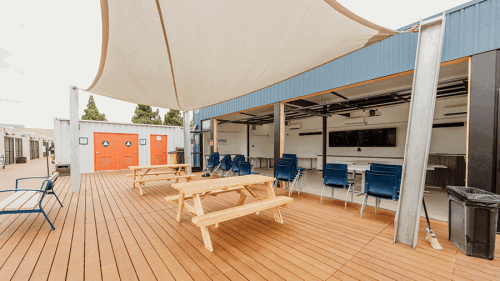Summary
This month’s data suggest that the real estate economy is continuing to turn in the right direction, albeit slowly and with a long way to go. Compared with one year ago, 55 percent of 64 key indicators in the Barometer were better while 36 percent were worse and 9 percent were unchanged.
Note: More commentary and data can be found throughout the tabs and in the accompanying tables.
Job creation was disappointing in January and the dip in unemployment had little to do with job growth. The good news is that fourth-quarter GDP rose from third-quarter levels, consumer confidence grew, retail sales are strong and have exceeded the pre-recession peak, and S&P 500 returns remained positive for the fifth-straight month. Of note is the increase in inflation (CPI), which rose at a monthly rate not seen for 20 months and exceeded its long-term monthly average.
The REIT sector and the NCREIF Property Index turned in positive monthly and quarterly returns. Property sales volumes jumped substantially over the previous month, with almost 32 percent of the total transaction value due to sales of CBD office space and 23 percent due to sales of apartment buildings.
CMBS issuance had a quiet month in January, but volume is expected to pick up in February. January’s CMBS delinquency rate reached a new high-yet again.
Vacancy and rental rates across all property types changed little, if at all, in the fourth quarter of 2010, consistent with a stabilizing pattern that unfolded, albeit slowly, throughout the year. Rents are now between 5 and 16 percent below their pre-recession peak. Vacancy rates for apartments are just above historical norms, while rates for all other property types remain well above historical norms.
Of note is the office absorption in the fourth quarter of 2010, which almost tripled from the previous quarter.
In housing news, permits and sales of all types of homes were up in December. Sales of single-family homes and condominiums are substantially above their long-term averages, while sales of new single-family homes remain historically low; still, only prices of new single-family homes have turned noticeably upward. Across the board, months’ supply decreased and pending home sales continue to rise. Foreclosure activity dipped for the third-straight month, this time only slightly.
Economy
Much of the recent economic data is positive, but the lack of sustained and substantial job growth remains the missing link to a well-paced recovery.
A net increase of 36,000 jobs in January was due to an increase of 50,000 private sector jobs (primarily in manufacturing, retail trade, and administrative and support services) and the loss of 14,000 government jobs (primarily in local government). Private sector job creation in January is disappointing compared with December’s private sector job growth of 139,000 jobs, but monthly private sector job growth has been seesawing for the past 12 months. A total of 945,000 jobs in all sectors has been created since January 2010. A net total of 7.7 million have been lost over the past three years.
The unemployment rate fell from 9.4 to 9.0 percent in January, a sharper decrease than was expected or that would have been indicated by job growth. January’s unemployment rate is the lowest since April 2009.
The advance estimate of fourth-quarter 2010 GDP growth is 3.2 percent, a welcome increase over third-quarter growth of 2.6 percent. The fourth-quarter growth rate exceeds the long-term quarterly average of 2.9 percent.
The Consumer Confidence Index rose to 60.6 in January from 53.3, after a dip in December. It is now 61 percent of January 2008’s level of 87.3. Retail sales grew 0.4 percent in December, the sixth-straight month of growth. December’s growth rate is the same as the long-term monthly average of 0.4 percent (since 1992). Actual retail sales volume—$380.9 billion—marginally exceeded the pre-recession peak of three years ago ($379.8 billion in November 2007).
Inflation, as measured by the Consumer Price Index, increased by 0.5 percent in December, the largest monthly increase since June 2009 and higher than the long-term monthly average of 0.4 percent (since 1970). December’s increase was due primarily to gasoline prices, as well as prices for household energy and fruits and vegetables. Over the past 12 months, the CPI has risen 1.5 percent.
January’s S&P 500 index saw positive returns of 2.4 percent, the fifth-straight month of positive returns. Year-over-year returns climbed from 15.1 percent in December to 22.2 percent as of the end of January—above the long-term average of 10.3 percent.
Real Estate Capital Markets
Returns and sales volumes are the good news in the real estate capital markets this month, while commercial property prices showed mixed results and CMBS delinquencies continue to rise.
Commercial property sales volume rose in December to $23.2 billion from $10.6 billion in November, according to Real Capital Analytics. While volume is not nearly as high as in the 2005-07 period, it is now almost 150 percent of the monthly average since 2001. This follows six straight months in which sales volumes were only between 58 and 69 percent of the historical monthly average.
The NCREIF Property Index turned in a positive fourth quarter in 2010, with total returns of 4.62 percent, making 2010 a full year of consistently positive returns; total returns for the past year are 13.1 percent. Total returns for the quarter by property sector show the highest returns for apartments, 6.29 percent, and the lowest returns for lodging/resorts, 3.35 percent and industrial property, 3.42 percent.
The Moody’s/REAL Commercial Property Price Index barely changed, rising a scant 0.6 percent in November. November was the third month in a row of increases, albeit at successively smaller rates, after three straight months of decline. (This index is reported monthly as a three-month moving average, with a two-month lag.) Values are now 58 percent of the peak value in October 2007. The Green Street Advisors’ Commercial Property Price Index, based on estimates of private market value for REIT portfolios rose 2.1 percent in November and 0.8 percent in December, but was virtually unchanged in January. It is now at 82 percent of the peak value in August 2007.
The REIT sector saw positive total returns in January of 4.1 percent, although they were down slightly from December’s returns. Total returns for the past year remain a very healthy 40.6 percent. Total returns for the month by property sector range from 5.9 percent for the office sector to 0.8 percent for the retail sector.
Capitalization rates, as reported by Real Capital Analytics, remained fairly steady at 7.24 percent in December, similar to November’s level of 7.36 percent. RCA’s cap rates remain above the 6.39 percent of June 2007, but are just below the historical norm of 7.6 percent (since 2001). Capitalization rates as reported by NCREIF remained steady at 6.30 percent in the fourth quarter of 2010, similar to the third quarter’s level of 6.47 percent. NCREIF’s cap rates remain above the 5.4 percent of the first quarter of 2008 but are below the historical norm of 7.6 percent (since 1978).
CMBS issuance slowed in January after sixth-straight months of improvements, according to Commercial Mortgage Alert, with $0.16 billion total issuance, none of which was a multiborrower deal. However, volume is expected to pick up in February when four transactions totaling $7.4 billion are likely to be priced. CMBS delinquency rates, according to Trepp LLC, increased to 9.34 percent in January, another record high.
For additional commentary on real estate capital markets, see the Capital Markets section of online Urban Land magazine.
Commercial/Multifamily
Vacancy and rental rates across all property types continued to stabilize, and vacancies actually declined in several sectors in the fourth quarter 2010. Rents are now between 5 and 16 percent below their pre-recession peak: apartment rents are down 5 percent from their peak, office rents are down 12 percent, retail rents are down 15 percent, the hotel revenue per available room (RevPAR) index is down 15 percent, and warehouse rents are down 16 percent. Vacancy rates for apartments are just above historical norms, while rates for all other property types remain well above historical norms.
Office vacancy rates stood at 18.6 percent in the fourth quarter of 2010; after a sustained vacancy rate of 18.9 percent in the previous three quarters, the vacancy rate has now returned to where it was in the fourth quarter a year ago, according to Property & Portfolio Research (the source of all data presented in this section). Completions in the fourth quarter, as a percentage of inventory, were 0.1 percent, the same as in the third quarter; this is substantially below the historical average of 0.7 percent. The absorption of 17.6 million square feet of space is almost triple the absorption of the previous quarter and continues the positive absorption first seen in the second quarter after seven consecutive quarters of negative absorption. Rents remained stable and are off just 1.5 percent from the same quarter a year ago.
Retail vacancy rates stood at 18.4 percent in the fourth quarter of 2010, down slightly from 18.8 percent in the third quarter and 80 basis points below the figure for the same quarter a year ago. Completions in the fourth quarter of 2010 as a percentage of inventory were 0.1 percent, the same as in the previous quarter and below the 0.6 percent historical average. Rents remained stable in the fourth quarter and are off 3.8 percent from the same quarter a year ago.
Warehouse vacancy rates stood at 12.2 percent in the fourth quarter of 2010, barely changing from 12.3 percent in the third quarter and 10 basis points below the figure for the same quarter a year ago. Completions in the fourth quarter of 2010 stood at 0.1 percent of inventory, the same as in the previous quarter and below the 0.6 percent historical average. Rents stayed about the same and are off 4.5 percent from the same quarter a year ago.
Apartment vacancy rates stood at 7.6 percent in the fourth quarter of 2010, the same as in the third quarter but 80 basis points below the figure for the same quarter a year ago. Completions in the third quarter of 2010 stood at 0.1 percent of inventory, the same as in the previous quarter and below the 0.4 percent historical average. Rents remained stable in the fourth quarter and are 1.9 percent above rents from the same quarter a year ago.
Hotel occupancy rates (a moving 12-month average) stood at 61.8 percent in the fourth quarter of 2010, up from 57.9 percent in the same quarter a year ago. Completions were down slightly as a percentage of rooms—from 3.1 percent in the fourth-quarter of 2009 to 1.7 percent—and are now below the historical average of 2.3 percent. The RevPAR Index was up 9.8 percent from the same quarter of 2009.
Housing
Permits and sales of new single-family homes jumped in December but remain at historically low levels, while prices were their highest since April 2008. Sales of existing single-family homes exceeded their long-term monthly average for the second-straight month, although prices remain depressed. The forward-looking National Association of Realtors’ (NAR) Index of Pending Sales (of existing single-family, condos, and coops) rose 2.0 percent in December after a 3.0 percent rise in November. Multifamily permits were at a high point not seen for three years.
Single-family building permits increased 17 percent from 417,000 in November to 440,000 in December and are now 45 percent of the monthly average (since 1970) and 24 percent of the pre-recession high of September 2005. Single-family starts decreased 9.0 percent from 458,000 in November to 417,000 and are now 38 percent of the monthly average (since 1970) and 23 percent of the pre-recession high of January 2006.
Sales of new single-family homes increased 18 percent to 329,000 in December, and supply decreased from 8.4 months to 6.9 months. Even with this jump in sales, monthly sales of new single-family homes since May have been at lows not seen since record keeping began in 1963. Median prices for new single-family homes were up 12 percent in December at $241,500 from November’s prices of $215,500. December’s price was the highest monthly price since April 2008.
The number of existing single-family home sales (seasonally adjusted) increased by 12 percent to 4.64 million in December, a level that now exceeds the long-term monthly average (since 1970); monthly supply decreased from 9.3 to 7.8 months. The S&P/Case-Shiller Index for existing home prices notched downward for the fourth-straight month; the November index is down 30 percent from the peak in July 2006. (This index is reported monthly as a three-month moving average, with a two-month lag.) NAR data also show existing single-family home prices notching downward in December after three straight months of decline; prices are down 24 percent from the peak in 2006.
Multifamily building permits increased by 61 percent to 172,000 in December, their highest point since December 2008. This follows on November’s permits that were at one of the lowest points in the low-level zigzag pattern seen over the past two years. Multifamily permits are now 44 percent of the monthly average (since 1970). Multifamily housing starts increased by 26 percent, following an 8 percent decline in November. Multifamily housing starts in December stood at 102,000, representing 29 percent of the monthly average (since 1970). Existing condo sales increased 16 percent to 640,000 and inventory increased by just 4 percent, so monthly supply slid from 11.1 months to 10.0 months. Prices of existing condominiums remained stable in December, according to NAR, and are 7.4 percent lower than they were last November.
Housing affordability remains near historical highs.
Foreclosure filings—default notices, scheduled auctions, and bank repossessions—decreased 1.7 percent in December from a month earlier to 257,747 filings, according to RealtyTrac. The firm attributes this slight drop, as well as November’s dramatic 21 percent drop—the largest monthly drop since RealtyTrac began publishing the data in 2005—to lenders and servicers slowing the foreclosure process to correct any irregularities in foreclosure processes and documents; the halted foreclosure activity is expected to re-start in 2011.
Home mortgage rates (30-year fixed) remained low—4.76 percent in December—but have edged up over the last three months.





